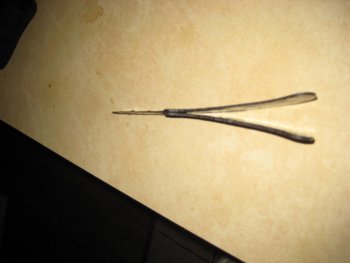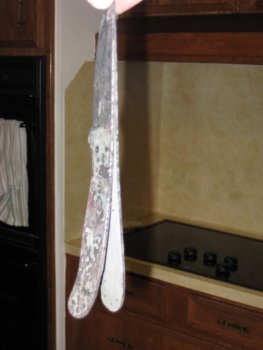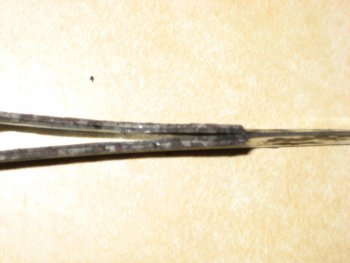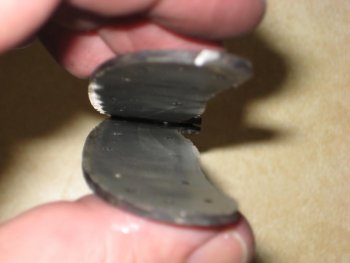As one of the great radio personalities of all time used to say, "Now it's time for the rest of the story... "
First of all, contrary to my own initial reaction and the suppositions of several here, the core is one piece. I fairly quickly came to this conclusion myself, even before I talked to the maker to confirm, because the split is far from uniform and because making 4 layer sandwich just doesn't make sense.
My oil MAY have been too fast, though I think it would have been perfect for the CruForge alone, and I believe that the completeness of the conversion to martensite (which is, of course, a larger molecular structure), coupled with the total lack of hardening in the wrought, essentially blew the knife apart. Using a slower oil might lessen the initial hardness, which seems like a tradeoff I'd not like to make. OF course, if that's the only alternative to a "reverse tapered tang" it might be the best way to go. The oil speed may also have been irrelevant, because this is the first time this maker of san mai has had a blade made from one of his hundreds of billets do this, and I know of several knifemakers who use his stuff in this exact combination of materials that have stated that they use Parks 50 without issue.
As others have mentioned, this core splitting has been noted to have occurred with L6 and O1 cores and non-hardening cladding, so it's a known potential issue. The question to me is not "why do san mai blades do this?," but rather "why did THIS blade do this when no others from this maker with this combination of materials have?" I still have no answer for this second question, though I feel pretty confident in the answer to the first.
Other than using more compatible materials in the first place (not an option for me at this point), solutions include heavily claying the spine and tang or edge quenching or both.
So, ultimately it appears that the only fault involved is the large one down the middle of my blade. I could have heat treated more appropriately had I known about the potential issues beforehand. The maker could have warned me, but as this had never happened to his materials before, there's no reason he would have known to. Similarly, he could have used a different combination of materials, but again, without having experienced such issues in the past there was no reason he should have done differently. From the theoretical perspective I suppose we both understand why this could happen, but neither of us considered that it might. To his great credit, the san mai maker seemed genuinely bummed that I lost what would have been a really, really nice blade, and has offered to replace the piece that was destroyed. You can't really ask for better service than that.
Randy, care to share your recipe?








